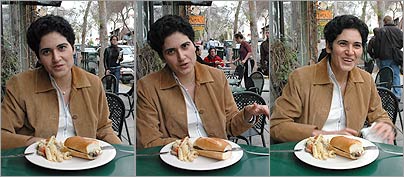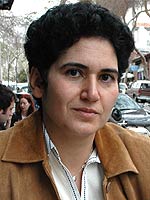UC Berkeley Web Feature
 |
Avideh Zakhor, UC Berkeley professor of electrical engineering, holds forth at Nefeli Café. (BAP photo) |
The Hungry Mind: Prof. Avideh Zakhor on being a science nerd in Iran, why Larry Summers made her mad, and what the heck a 4D model is
|
BERKELEY – Avideh Zakhor has been interested in engineering since she was a little girl growing up in Iran. "My father started the first button manufacturing factory in Tehran," she says in between quick bites of her Athenian sandwich. Since the Zakhors lived in the same building as the factory, "I was always downstairs watching how the workers made the buttons: they'd pull the resin in - the raw material was a byproduct of the Iranian petroleum industry - and a machine would cut it into discs. Another one would carve it, another put the holes in it, and then the coloring process. It fascinated me."
We're sitting outside at Nefeli's Café on Euclid Ave., around the corner from Zakhor's office at Cory Hall, where she is a professor of electrical engineering. Zakhor eats at the Greek café so often that she has an account. It's easy to see why. My Alpino sandwich is a tasty mix of savory and sweet: a crunchy french roll filled with prosciutto, fontina cheese, Anjou pears, roasted walnuts, and arugula. Zakhor's has roasted eggplant and red peppers, feta, onions, kalamata olive spread and parsley.
Contrary to stereotypes about women in the Middle East, Zakhor felt no stigma as a mechanically-minded Persian girl. "Not many people know this, but half of all college graduates in Iran are female," she says. "It wasn't always like that, but it's not that unusual." At 15, she won a prestigious scholarship from the Iranian government to study science and math at an international boarding school in Wales. Shortly after she got there, the Shah of Iran and his family were forced into exile, and Zakhor's family, like many of their countrymen, fled Iran and ended up in Los Angeles.
"A week after the government fell, the check for two years at school arrived," she laughs. Subsequent scholarship checks were also supposed to cover her college and graduate school costs, too, but those, of course, didn't materialize. After finishing high school in Wales, Zakhor chose the California Institute of Technology to be closer to her family. The male to female ratio in 1980, only eight years after Caltech began admitting women, was around 7 to 1. "The joke was that you could have a different boyfriend for each day of the week," she recalls. Not that she had time. After just three years, Zakhor graduated first in Caltech's engineering class of 1983. She then proceeded to speed through her Ph.D. in electrical engineering and computer science at the Massachusetts Institute of Technology in just four years.
"What was the rush?" I ask.
"I was so cold! I wanted to finish quick so I could come back to California," she says, shivering at the memory of chilly Boston. "I used to go to my lab at 2 in the afternoon and stay there until 6 in the morning because it was one gigantic winter, always cloudy and raining."
Tenure clock, meet biological clock
By 24, Zakhor was an assistant professor of electrical engineering at Berkeley. She got tenure six years later, in 1994, a few months before her son was born; and made full professor in 1998. (Zakhor is married to fellow Berkeley professor of electrical engineering Seth Sanders, who she says followed her west from MIT hoping for a date.)
 'If the men are working 80 hours a week, you work 85 hours. You have to continually prove that you're better.' -Avideh Zakhor |
Zakhor is particularly irritated when asked about the recent firestorm surrounding comments by Harvard President Larry Summers, in which he suggested that the reason so few women become scientists or engineers might be due to an innate difference from men in their abilities. "Women have a hard enough time competing in academia, not just in science and engineering, and comments like this just compound the problem," she says. "Deep down, I wonder how many people think the same thing as Summers but never say it."
She taps her water glass, thinking. "I know a lot of women who deliberately don't choose academic careers in science and engineering, because they see that what it takes to succeed conflicts with their personal goals of raising children and having a family," she continues. "The ones who choose it anyway sacrifice even more than men in my opinion, because they have to fight against this inherent bias that's ingrained in the system. If the men are working 80 hours a week, you work 85 hours. You have to continually prove that you're better."
Life begins at 4D
While Zakhor should have nothing left to prove, she's still in constant motion. She heads the Video and Image Processing Lab at Berkeley as well as Visualization MURI, a Multidisciplinary University Research Initiative in which researchers from five universities are developing four-dimensional dynamic models of the environment. On sabbatical from teaching this semester to finish a book about multimedia networking, she's also involved with TruVideo, the second company she's cofounded, which makes it possible for Verizon, Sprint and AllTel subscribers to watch video content on their phones.
As dissimilar as these projects sound, they all have something in common. "They're all about signal processing - compact ways of representing the world," she explains. A signal can be two-dimensional, like a digital image; processing it could entail compressing that signal into an MP3 or a JPG and figuring out how to put it back together. Add the element of depth, and you get a 3D image of an object that can be rotated and examined from all angles.
So far, so good. "But I'm afraid I can't wrap my brain around the concept of four-dimensional," I say.
"Four dimensions is just a three-dimensional object moving in time," she answers, speaking slowly. "Imagine you're recording the performance of a ballet dancer, so that when you watch it at a distant location you can view it from any angle and from any point in time."
"Like that shot in 'The Matrix' where the motion freezes and the cameras swing around Keanu Reeves?" I demonstrate by rotating my napkin around my fork.
 A portion of MURI's 3D Berkeley model: With the right software, viewers can look at this street from multiple angles, even seeing the other side of the theater marquee. |
But don't confuse this with "virtual reality," computer-simulated renderings. "I prefer to think of it as 'virtualizing' reality," says Zakhor.
As one might guess, the most immediate interest in a 4D city model is coming from the U.S. military. The Visualization MURI project indeed has been funded by the Army Research Office; the Defense Advanced Research Projects Agency (or DARPA, the federal agency that funded the creation of the Internet) will likely step in when the ARO grant ends in July. The project is not classified, and Zakhor doesn't see the application as limited by its potential military application. She's more excited by applications such as telesurgery, where doctors in San Francisco could use 4D video and a joystick to operate on patients in Alaska, say. (This is already happening using standard teleconferencing video.)
Mulling over what she's said, something occurs to me: "What do you watch 4D video with? A hologram projector like they used in Star Wars?"
"It's true, 4D viewers aren't really here yet," acknowledges Zakhor. "But they will be. Maybe even someday on your cell phone. Last year the number of cell phones exceeded the number of PCs - 1.5 billion to 1.3 billion. Who wants to carry around their PC? Your cell will be your iPod, your DVD player, your camera, your e-mail device, all of your entertainment and communication needs in one gadget."
And since someone will have to figure out how to process and transmit all those signals efficiently, chances are good that Zakhor won't be slowing her pace anytime soon. On our way out, Zakhor orders a double espresso — to go, of course.


